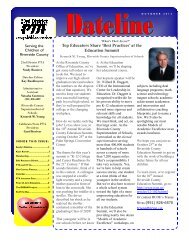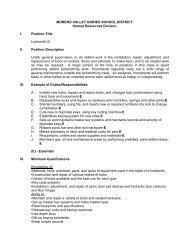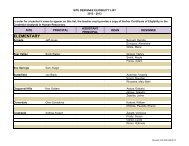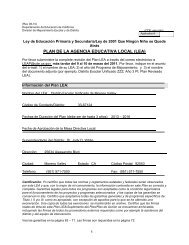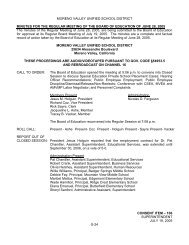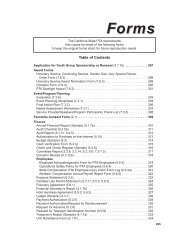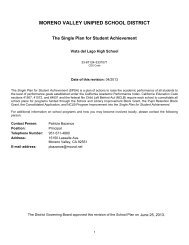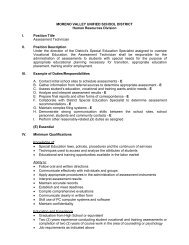Math: Kindergarten Instructional Cycle - Moreno Valley Unified ...
Math: Kindergarten Instructional Cycle - Moreno Valley Unified ...
Math: Kindergarten Instructional Cycle - Moreno Valley Unified ...
You also want an ePaper? Increase the reach of your titles
YUMPU automatically turns print PDFs into web optimized ePapers that Google loves.
<strong>Math</strong>: <strong>Kindergarten</strong><strong>Instructional</strong> <strong>Cycle</strong>1TABLE OF CONTENTSIntroductionPageThe What, Why, Who, When, and How 2The <strong>Instructional</strong> <strong>Cycle</strong>: A Puzzle Piece Graphic of Linked Instruction 5The Power Standards 6-7A Year-at-a-Glance (identifying the current instructional cycle and testing schedule) 9The <strong>Instructional</strong> <strong>Cycle</strong>’s Curriculum Overview for the Year 10-11Insert Subheading of each main content sectionPageThe Specific Section 13The Specific Section #The Specific Section #The Specific Section #Insert additional SubheadingPageThe Specific Section #The Specific Section #The Specific Section #The Specific Section #Once complete, highlight table, go to table design, click NO Border. Then, here is an example of how it will look printed…TABLE OF CONTENTSInsert Subheading of each TOC sectionPageThe Specific Section #The Specific Section #The Specific Section #The Specific Section #Insert Subheading of each TOC sectionPageThe Specific Section #The Specific Section #The Specific Section #TE = Teacher’s EditionPR = Printable Resources (Pouch or OAF =Algebra & FunctionsE = Students’s EditionSNP = SuccessNet PremiumMG = Measurement & GeometryUA = Universal AccessNS = Number SenseSDP = Statistics, Data, ProbabilityMVUSD Professional Development Dept. Scope & Sequence_<strong>Math</strong>_K_mpuckett_08012012-D4 1
1<strong>Instructional</strong> <strong>Cycle</strong><strong>Math</strong>: <strong>Kindergarten</strong>THE WHAT, WHO, WHY, AND HOW“What” is a Scope & Sequence?Under No Child Left Behind, the <strong>Moreno</strong> <strong>Valley</strong> <strong>Unified</strong> School District (MVUSD) has been identified as a programimprovement district. This means we need to change our instructional practices to improve student achievement.Consequently, the District is providing all of our teachers with a comprehensive Scope & Sequence curriculum,developed by teachers for teachers.A Scope & Sequence describes the depth and breadth of a particular curriculum. The Scope details the contentstandards in each of the core curricular areas. Additionally, the MVUSD has specified which content standards arepower standards—those standards needing to be emphasized and taught in greater depth for essential skillsmastery. The Sequence is aligned to the District’s assessment schedule, building toward student mastery of thespecified content standards, culminating in the District’s students taking the California Standards Test (CST).Using current educational research, the District has divided the school year into four, distinct <strong>Instructional</strong> <strong>Cycle</strong>s.The MVUSD Scope & Sequence is designed around these four, calendar-based <strong>Instructional</strong> <strong>Cycle</strong>s. Each cycleincludes days for teaching, assessing learning, diagnosing performance gaps, and reteaching or enriching keyconcepts.“Who” will use the Scope & Sequence?This Scope & Sequence will be used by teachers, administrators, instructional assistants, and staff—workingcollaboratively to provide excellent instruction to the students of <strong>Moreno</strong> <strong>Valley</strong>.It is to be a living, breathing set of documents. The Scope & Sequence will be released one <strong>Instructional</strong> <strong>Cycle</strong> at atime, incorporating real-time feedback and practical revisions to each release—designed by teachers, revised byteachers, and used by teachers.The Professional Learning Communities (PLC) at each site will find the Scope & Sequence a helpful tool in theircollaborative discussions—providing teachers a vehicle for planning daily lessons, reflective of best practices.“Why” use a Scope & Sequence?Teachers will want to use Scope & Sequence materials to save time, to learn best practices, to fostercollaboration with other educators, and to achieve better student-learning results.The MVUSD Scope & Sequence materials are carefully designed to provide a coordinated look at (1) standards,(2) instructional materials—including specific textbook references and multiple, differentiated instruction ideas,(3) additional strategies and resources, as well as (4) sample CST test questions.Also, teachers will find plenty of “white space” on the pages of the Scope & Sequence where they can note their ownclassroom ideas and success stories for:a. future reference in their instructional planning,b. future revisions of the Scope & Sequence materials,c. their ongoing subject-matter/grade-level PLC collaborations,d. yearly teacher/principal conferences, ande. continuing parent/teacher communications.TE = Teacher’s EditionPR = Printable Resources (Pouch or OAF =Algebra & FunctionsE = Students’s EditionSNP = SuccessNet PremiumMG = Measurement & GeometryUA = Universal AccessNS = Number SenseSDP = Statistics, Data, ProbabilityMVUSD Professional Development Dept. Scope & Sequence_<strong>Math</strong>_K_mpuckett_08012012-D4 2
<strong>Math</strong>: <strong>Kindergarten</strong><strong>Instructional</strong> <strong>Cycle</strong>1THE WHAT, WHO, WHY, AND HOW CONTINUED…Furthermore, by implementing the MVUSD Scope & Sequence, teachers will have immediate support in providingreal-time intervention for struggling students including English Language Learners (ELL) and students withspecial needs. Conversely, by using the instructional framework of the MVUSD Scope & Sequence, teachers willhave more opportunity to focus on higher-level questioning strategies and enrichment activities that developstudents’ critical thinking, deeper intellectual inquiry processes, and curricular-based performance activities.“How” will teachers use this Scope & Sequence?Teachers will use the Scope & Sequence in a sequential manner within each <strong>Instructional</strong> <strong>Cycle</strong>. Teachers shoulduse the most effective strategies and resources available for meeting the objectives within each lesson.To use the Scope & Sequence, it is helpful to note the structure of this document. Please take a moment to becomefamiliar with it. Of particular significance is the color-coding of the <strong>Instructional</strong> <strong>Cycle</strong>s. As the <strong>Instructional</strong><strong>Cycle</strong>s progress through the year, the blue color tones intensify, representing the increased depth of learning.The top corner of each page contains the corresponding puzzle icon, the number (1, 2, 3, or 4) of the <strong>Instructional</strong><strong>Cycle</strong> for the materials contained on that particular page, the subject area, and grade level. The bottom of eachpage has a footer, which includes key acronyms referenced throughout the document.The introduction of the Scope & Sequence contains some important and helpful information. First, Page 5 displaysthe <strong>Instructional</strong> <strong>Cycle</strong> puzzle graphic, used to distinguish each <strong>Instructional</strong> <strong>Cycle</strong> and its respective materials.Second, beginning on Page 6, the Power Standards are listed and color-coded, indicating in which <strong>Instructional</strong><strong>Cycle</strong> they will be assessed. Third, the Year-at-a-Glance is a critical study page. The Curriculum Overviewcompletes the introduction and provides the key focus areas to be taught, the number of days available to teachthe materials, and a list of the corresponding powers standards.Teachers should use the MVUSD Scope & Sequence to provide differentiated instruction to the various subgroupswithin the context of this Scope & Sequence. For instance, while the rate—at which material is taught in a higherlevel course—could be potentially accelerated, the completion of each <strong>Instructional</strong> <strong>Cycle</strong> should stillmaintain the timeframe given in the Scope & Sequence. Instead of completing the material faster and moving-onto the next concept, teachers should provide enrichment activities that explore concepts at a higher cognitive leveland in greater depth to enhance student learning.Please Note:While power standards have been identified to provide students a critical academic foundation, the opportunityto transition to the next grade level, and ultimately the skills needed to succeed in a global society …“Identifying power standards does not relieve teachers of the responsibility forteaching all the standards in the grade level or curricular area that they have beenassigned to teach. What is necessary is to make the important distinction-whichstandards are critical for student success, and which other ones can be given lessemphasis, taught and assessed as they relate to the concepts and skills within theidentified Power Standards.”Ainsworth, 2003Ultimately, the structure of the MVUSD Scope & Sequence documents aims to be user-friendly, accessible, helpful,and usable on a daily basis. We hope you enjoy this process and look forward to your feedback.TE = Teacher’s EditionPR = Printable Resources (Pouch or OAF =Algebra & FunctionsE = Students’s EditionSNP = SuccessNet PremiumMG = Measurement & GeometryUA = Universal AccessNS = Number SenseSDP = Statistics, Data, ProbabilityMVUSD Professional Development Dept. Scope & Sequence_<strong>Math</strong>_K_mpuckett_08012012-D4 3
1<strong>Instructional</strong> <strong>Cycle</strong><strong>Math</strong>: <strong>Kindergarten</strong>Page Left Intentionally BlankTE = Teacher’s EditionPR = Printable Resources (Pouch or OAF =Algebra & FunctionsE = Students’s EditionSNP = SuccessNet PremiumMG = Measurement & GeometryUA = Universal AccessNS = Number SenseSDP = Statistics, Data, ProbabilityMVUSD Professional Development Dept. Scope & Sequence_<strong>Math</strong>_K_mpuckett_08012012-D4 4
<strong>Math</strong>: <strong>Kindergarten</strong><strong>Instructional</strong> <strong>Cycle</strong>1THE INSTRUCTIONAL CYCLE AT MVUSD<strong>Instructional</strong><strong>Cycle</strong>4<strong>Instructional</strong><strong>Cycle</strong>1<strong>Instructional</strong><strong>Cycle</strong>3<strong>Instructional</strong><strong>Cycle</strong>2TE = Teacher’s EditionPR = Printable Resources (Pouch or OAF =Algebra & FunctionsE = Students’s EditionSNP = SuccessNet PremiumMG = Measurement & GeometryUA = Universal AccessNS = Number SenseSDP = Statistics, Data, ProbabilityMVUSD Professional Development Dept. Scope & Sequence_<strong>Math</strong>_K_mpuckett_08012012-D4 5
1<strong>Instructional</strong> <strong>Cycle</strong><strong>Math</strong>: <strong>Kindergarten</strong>NS 1.1POWER STANDARDS BY INSTRUCTIONAL CYCLEPower Standards<strong>Instructional</strong> <strong>Cycle</strong>Number Sense 1 2 3 4Compare two or more sets of objects (up to ten objects in each group) and identifywhich set is equal to, more than, or less than the other.NS 1.2 Count, recognize, represent, name, and order a number of objects (up to 30). X X XNS 2.1AF 1.1Use concrete objects to determine the answers to addition and subtractionproblems (for two numbers that are each less than 10).Algebra and Functions 1 2 3 4Identify, sort, and classify objects by attribute and identify objects that do notbelong to a particular group (e.g., all these balls are green, those are red).XXXXXTE = Teacher’s EditionPR = Printable Resources (Pouch or OAF =Algebra & FunctionsE = Students’s EditionSNP = SuccessNet PremiumMG = Measurement & GeometryUA = Universal AccessNS = Number SenseSDP = Statistics, Data, ProbabilityMVUSD Professional Development Dept. Scope & Sequence_<strong>Math</strong>_K_mpuckett_08012012-D4 6
<strong>Math</strong>: <strong>Kindergarten</strong><strong>Instructional</strong> <strong>Cycle</strong>1POWER STANDARDS BY INSTRUCTIONAL CYCLEPower Standards<strong>Instructional</strong> <strong>Cycle</strong>Measurement and Geometry 1 2 3 4MG 1.1MG 1.2MG 2.1Compare the length, weight, and capacity of objects by making direct comparisonswith reference objects (e.g., note which object is shorter, longer, taller, lighter,heavier, or holds more).Demonstrate an understanding of concepts of time (e.g., morning, afternoon,evening, today, yesterday, tomorrow, week, year) and tools that measure time(e.g., clock, calendar).Identify and describe common geometric objects (e.g., circle, triangle, square,rectangle, cube, sphere, and cone).XXXStatistics, Data Analysis, and Probability 1 2 3 4SDP1.2Identify, describe, and extend simple patterns (such as circles or triangles) byreferring to their shapes, sizes, or colors.XTE = Teacher’s EditionPR = Printable Resources (Pouch or OAF =Algebra & FunctionsE = Students’s EditionSNP = SuccessNet PremiumMG = Measurement & GeometryUA = Universal AccessNS = Number SenseSDP = Statistics, Data, ProbabilityMVUSD Professional Development Dept. Scope & Sequence_<strong>Math</strong>_K_mpuckett_08012012-D4 7
1<strong>Instructional</strong> <strong>Cycle</strong><strong>Math</strong>: <strong>Kindergarten</strong>TEACHER NOTES …TE = Teacher’s EditionPR = Printable Resources (Pouch or OAF =Algebra & FunctionsE = Students’s EditionSNP = SuccessNet PremiumMG = Measurement & GeometryUA = Universal AccessNS = Number SenseSDP = Statistics, Data, ProbabilityMVUSD Professional Development Dept. Scope & Sequence_<strong>Math</strong>_K_mpuckett_08012012-D4 8
MVUSD <strong>Instructional</strong> <strong>Cycle</strong>/Assessment Calendar 2012-2013July 2012M T W T F2 3 4 5 69 10 11 12 1316 17 18 19 2023 24 25 26 2730 31August 2012M T W T F1 2 36 7 8 9 1013 14 15 16 1720 21 22 23 2427 28 29 30 312012-13September 2012M T W T F3 4 5 6 710 11 12 13 1417 18 19 20 2124 25 26 27 28October 2012M T W T F1 2 3 4 58 9 10 11 1215 16 17 18 1922 23 24 25 2629 30 31January 2013M T W T F1 2 3 47 8 9 10 1114 15 16 17 1821 22 23 24 2528 29 30 31November 2012M T W T F1 25 6 7 8 912 13 14 15 1619 20 21 22 2326 27 28 29 30February 2013M T W T F14 5 6 7 811 12 13 14 1518 19 20 21 2225 26 27 28December 2012M T W T F3 4 5 6 710 11 12 13 1417 18 19 20 2124 25 26 27 2831March 2013M T W T F14 5 6 7 811 12 13 14 1518 19 20 21 2225 26 27 28 29April 2013M T W T F1 2 3 4 58 9 10 11 1215 16 17 18 1922 23 24 25 2629 30NOTESIMPORTANT DATES*Aug 15Oct 4Oct 5Oct 5-12Nov 9Dec 14Dec 17-21Dec 21Dec 17-18Dec 19-21Mar 5Mar 8Mar 11-15May 6-23May 31Jun 4-6Jun 4-6Jun 7First Day of SchoolLast Day to Scan Assessment 1MS: Parent Conferences<strong>Cycle</strong> 1: Reteach WeekES: Parent ConferencesLast Day to Scan Assessment 2ES/MS <strong>Cycle</strong> 2: Reteach WeekES/MS: Minimum DayHS <strong>Cycle</strong> 2: Reteach WeekHS: Final ExamsGr 4/7: STAR Writing SampleLast Day to Scan Assessment 3<strong>Cycle</strong> 3: Reteach WeekSTAR TESTINGES/MS: Minimum dayHS: Seniors’ GraduationHS: Gr 9-11 Final ExamsES/MS Last Day: Minimum DaynMay 2013M T W T F1 2 36 7 8 9 1013 14 15 16 1720 21 22 23 2427 28 29 30 31VARIABLE DATESES: Trimester10/31, 3/1MS: Trimester11/2, 3/1HS: Quarters10/12,12/21,3/22June 2013M T W T F3 4 5 6 710 11 12 13 1417 18 19 20 2124 25 26 27 28KEY<strong>Instructional</strong> <strong>Cycle</strong>s Aligned With Their RespectiveAssessment/Tests<strong>Instructional</strong><strong>Cycle</strong> 1 Assessment<strong>Cycle</strong> 1<strong>Instructional</strong><strong>Cycle</strong> 2 Assessment<strong>Cycle</strong> 2<strong>Instructional</strong><strong>Cycle</strong> 3<strong>Instructional</strong><strong>Cycle</strong> 4ReteachWeek<strong>Cycle</strong> 3 Assessment<strong>Cycle</strong> 4 Blueprint(Optional )STAR TestingHS – Final Exams# Minimum Day Final Scan DeadlineNon-StudentDayTeacher PrepDays/ Orientation
1<strong>Instructional</strong> <strong>Cycle</strong><strong>Math</strong>: <strong>Kindergarten</strong>THE INSTRUCTIONAL CYCLE’S CURRICULUM OVERVIEW4132<strong>Cycle</strong> Power Standard Focus Curriculum Resources Pacing1AF 1.1NS 1.2NS 1.1NS 1.2Objects can be Described,Analyzed, & Classified by theirAttributes through SortingThe Numbers One to Five canbe Used, Classified,Represented & Explored interms of EquivalenceThe Concepts of More orFewer can be Exploredthrough Comparison &RelationshipsTopic 1: 1-1, 1-2, 1-3, 1-4,1-5, 1-6Topic 2: 2-1, 2-2, 2-3, 2-4,2-5, 2-6, 2-7, 2-8Topic 3: 3-1, 3-2, 3-3, 3-4,3-5, 3-6, 3-7, 3-832 daysBenchmark Assessment 1 Scan—Analyze Data—Plan 4 daysReteach Performance Gaps Based on Assessment 1 results 5 days<strong>Cycle</strong> Power Standard Focus Curriculum Resources Pacing2NS 1.2NS 1.1NS 1.2NS 2.1The Numbers Six to Ten can beUsed, Classified, Represented &Explored in terms ofEquivalenceA Number’s Relationship toAnother Number can be Usefulwhen Comparing NumbersAddition Operation Meanings& Models and their Relation toOther OperationsTopic 4: 4-1, 4-2, 4-3, 4-4, 4-5,4-6, 4-7, 4-8, 4-9,4-10, 4-11, 4-12,4-13, 4-14Topic 5: 5-1, 5-2, 5-3, 5-4,5-5, 5-6, 5-7, 5-8,5-9, 5-10Topic 6: 6-1, 6-2, 6-3, 6-4,6-5, 6-6, 6-733 daysBenchmark Assessment 2 Scan—Analyze Data—Plan 5 daysReteach Performance Gaps Based on Assessment 2 results 5 daysNOTE: The bolded numbers denote lessons that teach the Power StandardsTE = Teacher’s EditionPR = Printable Resources (Pouch or OAF =Algebra & FunctionsE = Students’s EditionSNP = SuccessNet PremiumMG = Measurement & GeometryUA = Universal AccessNS = Number SenseSDP = Statistics, Data, ProbabilityMVUSD Professional Development Dept. Scope & Sequence_<strong>Math</strong>_K_mpuckett_08012012-D4 10
<strong>Math</strong>: <strong>Kindergarten</strong><strong>Instructional</strong> <strong>Cycle</strong>1CONTINUED …3<strong>Cycle</strong> Power Standard Focus Curriculum Resources PacingNS 2.1NS 1.2NS 1.2SDAP 1.2Subtraction OperationMeanings & Models and theirRelation to Other OperationsThe Numbers to Twenty canbe Used, Classified,Represented & Explored interms of EquivalenceThe Numbers to Thirty can beUsed, Classified, Represented &Explored in terms ofEquivalencePatterns & Relationships canbe Described in Situations thatRepeat in Predictable WaysTopic 7: 7-1, 7-2, 7-3, 7-4,7-5, 7-6, 7-7Topic 8: 8-1, 8-2, 8-3, 8-4,8-5, 8-6Topic 9: 9-1, 9-2, 9-3, 9-4,9-5, 9-6, 9-7, 9-8Topic 10: 10-1, 10-2, 10-3,10-4, 10-5, 10-6,10-732 daysBenchmark Assessment 3 Scan—Analyze Data—Plan 5 daysReteach Performance Gaps Based on Assessment 3 results 5 days<strong>Cycle</strong> Power Standard Focus Curriculum Resources Pacing4MG 2.1MG 1.1Geometry: Shapes and Solidscan be Described, Classified, &Analyzed by their AttributesLength, Capacity, & Weightare Attributes that can beMeasured, Compared, &Topic 11: 11-1, 11-2,11-3,11-4, 11-5, 11-6,11-7, 11-8Topic 12: 12-1, 12-2, 12-3,12-4, 12-5, 12-6,12-7MG 1.1 Quantified in Different WaysTopic 13: 13-1, 13-2, 13-3,13-4, 13-5, 13-6,13-7MG 1.2Attributes of Time andCalendar can be Quantified,Measured, & Follow PatternsTopic 14: 14-1, 14-2, 14-3,14-4, 14-5, 14-6,14-7MG 1.2 Topic 15: 15-1, 15-2, 15-3,15-4, 15-5Questions can be Answered byCollecting & Analyzing theAppropriate DataAssessment—To Be DeterminedTopic 16: 16-1, 16-2, 16-3,16-4, 16-545 daysTE = Teacher’s EditionPR = Printable Resources (Pouch or OAF =Algebra & FunctionsE = Students’s EditionSNP = SuccessNet PremiumMG = Measurement & GeometryUA = Universal AccessNS = Number SenseSDP = Statistics, Data, ProbabilityMVUSD Professional Development Dept. Scope & Sequence_<strong>Math</strong>_K_mpuckett_08012012-D4 11




